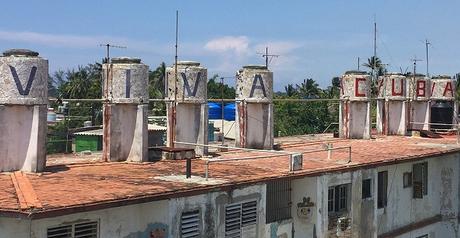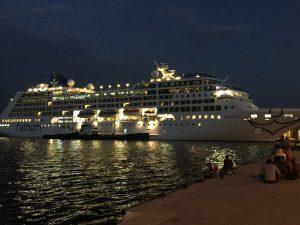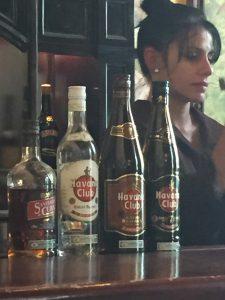
For the past 50+ years, the idea of traveling to Cuba on an American cruise line has been unfathomable. Then, in May of 2016, that idea became a reality – it became fathomable. Justifiably so, the first cruise line granted access into Cuba’s mesmerizing culture is named Fathom. Fathom Impact + Travel, a subsidiary company of Carnival Cruise lines, was created in 2012 and been in business since 2014. Fathom Impact + Travel is the answer to the belief that there is a demographic of travelers that is currently not attracted to cruising. Fathom offers participants the opportunity to travel with a purpose, creating transformative experiences through cultural immersion and person to person opportunities in both Cuba and the Dominican Republic. However, Fathom was created to attract a new demographic of people to cruising, not necessarily to get cruisers to Cuba! Whatever your reason may be, setting sail with Fathom Impact + Travel is a journey to Cuba you will not regret.
I began my week long journey boarding the Adonia, a small cruise ship (700 passenger maximum, although this cruise had only 450 passengers) in Miami to a friendly staff and gorgeous décor from floor to floor. After the typical excitement of being on a cruise ship subsided, I began to investigate what I could learn about Cuba over the next 2 days while we sailed to the country that for many years Americans were not allowed to visit. What was once a dream, was about to become a reality and that was thrilling!!

Cuba charges a 10% tax when converting US dollars, so if you can pull out Canadian Dollars or Euros from the bank prior to visiting Cuba and exchange those to CUCs upon arrival into Cuba you can avoid the 10% tax. Americans are allowed to bring back $400 in souvenir goods (except for cultural and educational materials like books, music and art, which is unlimited). Only $100 of that can account for alcohol and tobacco. It doesn’t sound like a lot, but rum is incredibly cheap (the nicest rum I purchased was a 40 CUC bottle of Santiago rum, aged 11 years – we were told by multiple people, including travel agents and local Cubans, that this was the best!) Smaller bottles cost anywhere as low as 2 and 4 CUCs. Cigars are more expensive, and I imagine are good, but I am not a smoker, so I didn’t look too much into cigars. Cigars are typically 9 CUCs per cigar.
The exception to this $100 limit is on rum and cigars you bring on to the ship to consume before arriving back in the US! Unlike your typical cruise ship, when you bring your alcohol and tobacco on board, the Adonia crew does not confiscate it and return it to you when you arrive back in the US. They allow you to carry it back on board with you and keep it in your stateroom. So on our first day in Cuba, we bought a small bottle of rum or 4 CUCs to sample in our stateroom. The rum was smooth and spicy and unlike any $4 bottle of rum I have ever tasted in the US. It is also a great way to keep your on board costs down, so you are not buying alcoholic beverages every night. Although, the alcoholic beverages on board were not overly priced. My family visited the ship’s wine bar every night before dinner to share a bottle of wine. We found great tasting wines for 25-30 dollars. The prices went up from there. They also offer various sizes of single glasses of wine for decent prices as well.

In our intro to Cuba session, we were also warned to negotiate any ride before getting into a taxi. There are multiple forms of taxis in Cuba, ranging from pedi cabs, to coco taxis, to typical taxi cars and the most luxurious old classic American cars. The cars are amazing, and I will make mention of them further into my journey.
Finally, we were advised what the typical tipping structure looked like:
- 4-6 CUCs per person, per day for tour guides,
- 2-3 CUCs per person, per day for drivers,
- 2-3 CUCs to waiters, and
- 1 CUC or less to street performers for photos.
Upon further investigating, we learned that these tips accounted for a large sum of a Cuban workers daily income (since they are getting paid in CUCs rather than CUPs).
Our second day of educational at sea programming included a session on Cuban history before the 20th century and a look into capturing photography on the street. After feeling better equipped with new knowledge about Cuba, we were ready to venture out into what would prove to be an amazing country with delightfully friendly people.

I asked one of the Impact Guides about my observation and he shared that the staff was encouraged to get to know the passengers in this way. If the culture of Fathom is going to be to create people to people experiences for the passengers with the local Cuban people, that needed to start on board the ship and be a theme throughout every aspect of the cruise experience. It is definitely a nice change from the type of cruising I am used to. This culture truly sets the tone for a most meaningful land experience in Cuba. By the end of day two, we went to bed eager to see wat Cuba had in store for us!

